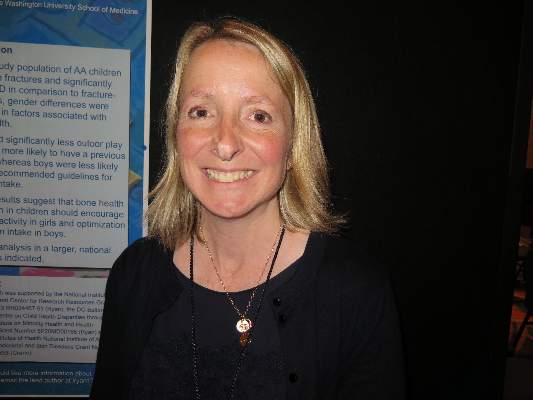User login
American Academy of Pediatrics (AAP): 2014 National Conference and Exhibition
VIDEO: Telepsychiatry can reach children in underserved communities
SAN DIEGO – Telemedicine services can reach children with mental health needs in underserved rural and urban communities, but physicians must know how to find those services.
In a video interview at the annual meeting of the American Academy of Pediatrics, Dr. Jane Oski of Tuba City (Ariz.) Regional Health Care explains how Medicaid reimbursement for such services varies by state, and where physicians treating children in underserved areas should start in their search for telepsychiatry services and resources.
The video associated with this article is no longer available on this site. Please view all of our videos on the MDedge YouTube channel
SAN DIEGO – Telemedicine services can reach children with mental health needs in underserved rural and urban communities, but physicians must know how to find those services.
In a video interview at the annual meeting of the American Academy of Pediatrics, Dr. Jane Oski of Tuba City (Ariz.) Regional Health Care explains how Medicaid reimbursement for such services varies by state, and where physicians treating children in underserved areas should start in their search for telepsychiatry services and resources.
The video associated with this article is no longer available on this site. Please view all of our videos on the MDedge YouTube channel
SAN DIEGO – Telemedicine services can reach children with mental health needs in underserved rural and urban communities, but physicians must know how to find those services.
In a video interview at the annual meeting of the American Academy of Pediatrics, Dr. Jane Oski of Tuba City (Ariz.) Regional Health Care explains how Medicaid reimbursement for such services varies by state, and where physicians treating children in underserved areas should start in their search for telepsychiatry services and resources.
The video associated with this article is no longer available on this site. Please view all of our videos on the MDedge YouTube channel
AT THE AAP NATIONAL CONFERENCE
Pit bull bites are worse by several measures
SAN DIEGO – Pit bulls caused 42% of dog bites for which children were hospitalized, a 4-year retrospective study showed.
Bites by pit bulls had a 40% greater odds of a full trauma team response, and were linked to a 3-day longer mean hospital stay, compared with bites by other dogs [4.2 days (standard deviation, 5.1) vs. 1.3 days (SD, 1.3); P = .02], reported lead author Dr. Claudia Yeung of Arizona Children’s Center and Maricopa Integrated Health System in Phoenix.“It’s the young children who are most affected, and the dog is often in the home,” Dr. Yeung added. Adults need to be informed about the risks that pit bulls and other large dog breeds may pose to young children, even if the dog is a pet with no known history of aggression, Dr. Yeung said at the annual meeting of the American Academy of Pediatrics.
Of about 885,000 dog bites that need medical attention in the United States every year, half are in children, according to the Centers for Disease Control and Prevention. To understand predictors of bite severity, Dr. Yeung and her colleagues reviewed the medical charts of children and adolescents who presented with dog bites to the emergency department at Arizona Children’s Center from March 2010 through March 2014.<b/>A total of 223 children presented, of whom 33 (14.8%) were hospitalized and 12 (5.4%) required the response of a full trauma team, Dr. Yeung said.
Hospitalized children in the study averaged just 6 years of age (SD, 4 years), and almost 82% needed surgical intervention in the operating room, she added. Children younger than age 5 years were more likely to sustain injuries to the face or neck than were older children (51% vs. 21%; P = .001), she reported.
Besides pit bulls, the most commonly reported culprits were German shepherds, Rottweilers, and Labrador retrievers, Dr. Yeung said.
A limitation of the study was that some medical records lacked data on the breed of the dog, Dr. Yeung added.
She reported no external funding sources or financial conflicts.
SAN DIEGO – Pit bulls caused 42% of dog bites for which children were hospitalized, a 4-year retrospective study showed.
Bites by pit bulls had a 40% greater odds of a full trauma team response, and were linked to a 3-day longer mean hospital stay, compared with bites by other dogs [4.2 days (standard deviation, 5.1) vs. 1.3 days (SD, 1.3); P = .02], reported lead author Dr. Claudia Yeung of Arizona Children’s Center and Maricopa Integrated Health System in Phoenix.“It’s the young children who are most affected, and the dog is often in the home,” Dr. Yeung added. Adults need to be informed about the risks that pit bulls and other large dog breeds may pose to young children, even if the dog is a pet with no known history of aggression, Dr. Yeung said at the annual meeting of the American Academy of Pediatrics.
Of about 885,000 dog bites that need medical attention in the United States every year, half are in children, according to the Centers for Disease Control and Prevention. To understand predictors of bite severity, Dr. Yeung and her colleagues reviewed the medical charts of children and adolescents who presented with dog bites to the emergency department at Arizona Children’s Center from March 2010 through March 2014.<b/>A total of 223 children presented, of whom 33 (14.8%) were hospitalized and 12 (5.4%) required the response of a full trauma team, Dr. Yeung said.
Hospitalized children in the study averaged just 6 years of age (SD, 4 years), and almost 82% needed surgical intervention in the operating room, she added. Children younger than age 5 years were more likely to sustain injuries to the face or neck than were older children (51% vs. 21%; P = .001), she reported.
Besides pit bulls, the most commonly reported culprits were German shepherds, Rottweilers, and Labrador retrievers, Dr. Yeung said.
A limitation of the study was that some medical records lacked data on the breed of the dog, Dr. Yeung added.
She reported no external funding sources or financial conflicts.
SAN DIEGO – Pit bulls caused 42% of dog bites for which children were hospitalized, a 4-year retrospective study showed.
Bites by pit bulls had a 40% greater odds of a full trauma team response, and were linked to a 3-day longer mean hospital stay, compared with bites by other dogs [4.2 days (standard deviation, 5.1) vs. 1.3 days (SD, 1.3); P = .02], reported lead author Dr. Claudia Yeung of Arizona Children’s Center and Maricopa Integrated Health System in Phoenix.“It’s the young children who are most affected, and the dog is often in the home,” Dr. Yeung added. Adults need to be informed about the risks that pit bulls and other large dog breeds may pose to young children, even if the dog is a pet with no known history of aggression, Dr. Yeung said at the annual meeting of the American Academy of Pediatrics.
Of about 885,000 dog bites that need medical attention in the United States every year, half are in children, according to the Centers for Disease Control and Prevention. To understand predictors of bite severity, Dr. Yeung and her colleagues reviewed the medical charts of children and adolescents who presented with dog bites to the emergency department at Arizona Children’s Center from March 2010 through March 2014.<b/>A total of 223 children presented, of whom 33 (14.8%) were hospitalized and 12 (5.4%) required the response of a full trauma team, Dr. Yeung said.
Hospitalized children in the study averaged just 6 years of age (SD, 4 years), and almost 82% needed surgical intervention in the operating room, she added. Children younger than age 5 years were more likely to sustain injuries to the face or neck than were older children (51% vs. 21%; P = .001), she reported.
Besides pit bulls, the most commonly reported culprits were German shepherds, Rottweilers, and Labrador retrievers, Dr. Yeung said.
A limitation of the study was that some medical records lacked data on the breed of the dog, Dr. Yeung added.
She reported no external funding sources or financial conflicts.
Key clinical point: Bites by pit bulls and other large dog breeds remain a serious threat to young children.
Major finding: Pit bulls caused 42.4% of dog bites that required hospitalization.
Data source: A retrospective chart review of 223 children presenting to an emergency department with dog bites.
Disclosures: Dr. Yeung did not report external funding sources and declared no financial conflicts.
Sex differences seen in fracture risk among children
SAN DIEGO – Results from a study of children with forearm fractures found that girls had less outdoor play and were more likely to have a previous fracture, compared with boys, while boys were less likely to meet recommended guidelines for calcium intake.
“An increasing amount of research is demonstrating that children who have fractures, in particular forearm fractures, are demonstrating signs of poor bone health,” Dr. Leticia Manning Ryan said in an interview at the annual meeting of the American Academy of Pediatrics. “Prior studies have shown that kids with forearm fractures have lower bone mineral density and vitamin D deficiency, compared to children who don’t have fractures. Other studies have focused on Caucasian kids, and my work to date has focused on African American kids.”
In an effort to identify pertinent gender differences in children with a forearm fracture, help tailor prevention strategies, and promote bone health in childhood, Dr. Ryan and her associates prospectively evaluated 76 African American children with a forearm fracture and 74 age-matched controls without a fracture who were treated at Children’s National Medical Center, Washington. Measures of interest focused on the study population with fractures and included body mass index, dietary intake, outdoor play time, bone mineral density (BMD), and level of serum 25-hydroxyvitamin D. The researchers used descriptive statistics to evaluate gender differences in clinical characteristics that might affect bone health, including socioeconomic status, vitamin D concentration, BMD, mechanism of injury, history of prior fracture, level of physical activity, milk intake, and calcium intake.
Dr. Ryan and her associates found that a significantly higher proportion of girls had a prior fracture, compared with boys (21.9% vs. 4.5%; P = .04). Girls reported significantly less outdoor playing time per week, compared with boys (a mean of 13.6 vs. 18.3 hours; P = .004) and a higher proportion of outdoor playing time that lasted 1 hour or less per day (28.1% vs. 6.9%; P = .02).
“I was surprised that the girls were more likely to have a prior fracture, which is kind of a red flag in terms of a child who is potentially at risk for continuing to have fractures moving forward through life,” said Dr. Ryan, who is a pediatric emergency medicine physician at Johns Hopkins Children’s Center, Baltimore.
She and her associates also found that boys were significantly less likely than girls to meet the 2010 Recommended Dietary Allowance for calcium intake (19% vs. 40.6%; P = .04).
“If your child has a fracture, I think it’s important to take a step back to consider whether or not they are doing everything they can to build strong bones during childhood,” Dr. Ryan said. “That includes getting safe but good weight-bearing exercise, making sure that they’re meeting calcium intake, and checking to make sure that their vitamin D levels are normal, especially in a child who has had more than one fracture.”
Although the study was limited to African American children, she expects that the findings would apply to children from other ethnicities. “There is more that we need to be doing during childhood to build strong bones, as kids reach their peak bone mass around age 18,” she concluded.
The study was supported by the National Center for Research Resources, the D.C.-Baltimore Research Center on Child Health Disparities through the National Institute on Minority Health and Health Disparities, and the National Institute of Arthritis and Musculoskeletal and Skin Diseases. Dr. Ryan reported having no financial disclosures.
On Twitter @dougbrunk
SAN DIEGO – Results from a study of children with forearm fractures found that girls had less outdoor play and were more likely to have a previous fracture, compared with boys, while boys were less likely to meet recommended guidelines for calcium intake.
“An increasing amount of research is demonstrating that children who have fractures, in particular forearm fractures, are demonstrating signs of poor bone health,” Dr. Leticia Manning Ryan said in an interview at the annual meeting of the American Academy of Pediatrics. “Prior studies have shown that kids with forearm fractures have lower bone mineral density and vitamin D deficiency, compared to children who don’t have fractures. Other studies have focused on Caucasian kids, and my work to date has focused on African American kids.”
In an effort to identify pertinent gender differences in children with a forearm fracture, help tailor prevention strategies, and promote bone health in childhood, Dr. Ryan and her associates prospectively evaluated 76 African American children with a forearm fracture and 74 age-matched controls without a fracture who were treated at Children’s National Medical Center, Washington. Measures of interest focused on the study population with fractures and included body mass index, dietary intake, outdoor play time, bone mineral density (BMD), and level of serum 25-hydroxyvitamin D. The researchers used descriptive statistics to evaluate gender differences in clinical characteristics that might affect bone health, including socioeconomic status, vitamin D concentration, BMD, mechanism of injury, history of prior fracture, level of physical activity, milk intake, and calcium intake.
Dr. Ryan and her associates found that a significantly higher proportion of girls had a prior fracture, compared with boys (21.9% vs. 4.5%; P = .04). Girls reported significantly less outdoor playing time per week, compared with boys (a mean of 13.6 vs. 18.3 hours; P = .004) and a higher proportion of outdoor playing time that lasted 1 hour or less per day (28.1% vs. 6.9%; P = .02).
“I was surprised that the girls were more likely to have a prior fracture, which is kind of a red flag in terms of a child who is potentially at risk for continuing to have fractures moving forward through life,” said Dr. Ryan, who is a pediatric emergency medicine physician at Johns Hopkins Children’s Center, Baltimore.
She and her associates also found that boys were significantly less likely than girls to meet the 2010 Recommended Dietary Allowance for calcium intake (19% vs. 40.6%; P = .04).
“If your child has a fracture, I think it’s important to take a step back to consider whether or not they are doing everything they can to build strong bones during childhood,” Dr. Ryan said. “That includes getting safe but good weight-bearing exercise, making sure that they’re meeting calcium intake, and checking to make sure that their vitamin D levels are normal, especially in a child who has had more than one fracture.”
Although the study was limited to African American children, she expects that the findings would apply to children from other ethnicities. “There is more that we need to be doing during childhood to build strong bones, as kids reach their peak bone mass around age 18,” she concluded.
The study was supported by the National Center for Research Resources, the D.C.-Baltimore Research Center on Child Health Disparities through the National Institute on Minority Health and Health Disparities, and the National Institute of Arthritis and Musculoskeletal and Skin Diseases. Dr. Ryan reported having no financial disclosures.
On Twitter @dougbrunk
SAN DIEGO – Results from a study of children with forearm fractures found that girls had less outdoor play and were more likely to have a previous fracture, compared with boys, while boys were less likely to meet recommended guidelines for calcium intake.
“An increasing amount of research is demonstrating that children who have fractures, in particular forearm fractures, are demonstrating signs of poor bone health,” Dr. Leticia Manning Ryan said in an interview at the annual meeting of the American Academy of Pediatrics. “Prior studies have shown that kids with forearm fractures have lower bone mineral density and vitamin D deficiency, compared to children who don’t have fractures. Other studies have focused on Caucasian kids, and my work to date has focused on African American kids.”
In an effort to identify pertinent gender differences in children with a forearm fracture, help tailor prevention strategies, and promote bone health in childhood, Dr. Ryan and her associates prospectively evaluated 76 African American children with a forearm fracture and 74 age-matched controls without a fracture who were treated at Children’s National Medical Center, Washington. Measures of interest focused on the study population with fractures and included body mass index, dietary intake, outdoor play time, bone mineral density (BMD), and level of serum 25-hydroxyvitamin D. The researchers used descriptive statistics to evaluate gender differences in clinical characteristics that might affect bone health, including socioeconomic status, vitamin D concentration, BMD, mechanism of injury, history of prior fracture, level of physical activity, milk intake, and calcium intake.
Dr. Ryan and her associates found that a significantly higher proportion of girls had a prior fracture, compared with boys (21.9% vs. 4.5%; P = .04). Girls reported significantly less outdoor playing time per week, compared with boys (a mean of 13.6 vs. 18.3 hours; P = .004) and a higher proportion of outdoor playing time that lasted 1 hour or less per day (28.1% vs. 6.9%; P = .02).
“I was surprised that the girls were more likely to have a prior fracture, which is kind of a red flag in terms of a child who is potentially at risk for continuing to have fractures moving forward through life,” said Dr. Ryan, who is a pediatric emergency medicine physician at Johns Hopkins Children’s Center, Baltimore.
She and her associates also found that boys were significantly less likely than girls to meet the 2010 Recommended Dietary Allowance for calcium intake (19% vs. 40.6%; P = .04).
“If your child has a fracture, I think it’s important to take a step back to consider whether or not they are doing everything they can to build strong bones during childhood,” Dr. Ryan said. “That includes getting safe but good weight-bearing exercise, making sure that they’re meeting calcium intake, and checking to make sure that their vitamin D levels are normal, especially in a child who has had more than one fracture.”
Although the study was limited to African American children, she expects that the findings would apply to children from other ethnicities. “There is more that we need to be doing during childhood to build strong bones, as kids reach their peak bone mass around age 18,” she concluded.
The study was supported by the National Center for Research Resources, the D.C.-Baltimore Research Center on Child Health Disparities through the National Institute on Minority Health and Health Disparities, and the National Institute of Arthritis and Musculoskeletal and Skin Diseases. Dr. Ryan reported having no financial disclosures.
On Twitter @dougbrunk
AT THE AAP NATIONAL CONFERENCE
Key clinical point: Bone health promotion in children should encourage physical activity in girls and optimization of calcium intake in boys.
Major finding: A significantly higher proportion of girls had a prior fracture, compared with boys (21.9% vs. 4.5%; P = .04), while boys were significantly less likely than girls to meet the 2010 Recommended Dietary Allowance for calcium intake (19% vs. 40.6%; P = .04).
Data source: A prospective evaluation of 76 African American children with a forearm fracture and 74 age-matched controls without a fracture who were treated at Children’s National Medical Center, Washington.
Disclosures: The study was supported by the National Center for Research Resources, the D.C.-Baltimore Research Center on Child Health Disparities through the National Institute on Minority Health and Health Disparities, and the National Institute of Arthritis and Musculoskeletal and Skin Diseases. Dr. Ryan reported having no financial disclosures.
Visual Acuity Screening Essential for Preschoolers
SAN DIEGO – Screening preschoolers with an evidence-based eye chart is essential for detecting amblyopia in time to treat it successfully, said Dr. Geoffrey E. Bradford.
“School-age vision screening is really too late to effectively start treating amblyopia,” he said at the annual meeting of the American Academy of Pediatrics.
Amblyopia affects about 4.5 million children in the United States, causing one or both eyes to transmit blurred images to the developing visual cortex. The condition begins to resist treatment by age 5 years and causes permanent vision loss by age 7 years, noted Dr. Bradford, professor of ophthalmology at West Virginia University in Morgantown.
For this reason, the AAP and the American Association for Pediatric Opthalmology and Strabismus (AAPOS) recommend visual acuity screening for children beginning at 36-47 months of age, Dr. Bradford said.
Pediatricians should use the Lea symbols or HOTV charts, make sure the eye that is not being tested is adequately covered, and refer patients aged 36 to 47 months who cannot correctly identify most optotypes on the 20/50 line of the chart. The same criteria apply to the 20/40 line of the chart when testing children aged 48 to 57 months, he said. While still used in some practices, the “sailboat” chart lacks scientific evidence and is not recommended, and the tumbling E chart is not reliable in young children. “Testing should be done at 10 feet, not at 20 feet,” he added. “There are eye charts calibrated for 10 feet, and that’s really more accurate because the screener is better able to engage the child at 10 feet away.”
A kit with evidence-based, age-appropriate visual acuity charts, adhesive occlusion patches, and other useful items is available from AAPOS, Dr. Bradford noted. He reported no conflicts of interest.
SAN DIEGO – Screening preschoolers with an evidence-based eye chart is essential for detecting amblyopia in time to treat it successfully, said Dr. Geoffrey E. Bradford.
“School-age vision screening is really too late to effectively start treating amblyopia,” he said at the annual meeting of the American Academy of Pediatrics.
Amblyopia affects about 4.5 million children in the United States, causing one or both eyes to transmit blurred images to the developing visual cortex. The condition begins to resist treatment by age 5 years and causes permanent vision loss by age 7 years, noted Dr. Bradford, professor of ophthalmology at West Virginia University in Morgantown.
For this reason, the AAP and the American Association for Pediatric Opthalmology and Strabismus (AAPOS) recommend visual acuity screening for children beginning at 36-47 months of age, Dr. Bradford said.
Pediatricians should use the Lea symbols or HOTV charts, make sure the eye that is not being tested is adequately covered, and refer patients aged 36 to 47 months who cannot correctly identify most optotypes on the 20/50 line of the chart. The same criteria apply to the 20/40 line of the chart when testing children aged 48 to 57 months, he said. While still used in some practices, the “sailboat” chart lacks scientific evidence and is not recommended, and the tumbling E chart is not reliable in young children. “Testing should be done at 10 feet, not at 20 feet,” he added. “There are eye charts calibrated for 10 feet, and that’s really more accurate because the screener is better able to engage the child at 10 feet away.”
A kit with evidence-based, age-appropriate visual acuity charts, adhesive occlusion patches, and other useful items is available from AAPOS, Dr. Bradford noted. He reported no conflicts of interest.
SAN DIEGO – Screening preschoolers with an evidence-based eye chart is essential for detecting amblyopia in time to treat it successfully, said Dr. Geoffrey E. Bradford.
“School-age vision screening is really too late to effectively start treating amblyopia,” he said at the annual meeting of the American Academy of Pediatrics.
Amblyopia affects about 4.5 million children in the United States, causing one or both eyes to transmit blurred images to the developing visual cortex. The condition begins to resist treatment by age 5 years and causes permanent vision loss by age 7 years, noted Dr. Bradford, professor of ophthalmology at West Virginia University in Morgantown.
For this reason, the AAP and the American Association for Pediatric Opthalmology and Strabismus (AAPOS) recommend visual acuity screening for children beginning at 36-47 months of age, Dr. Bradford said.
Pediatricians should use the Lea symbols or HOTV charts, make sure the eye that is not being tested is adequately covered, and refer patients aged 36 to 47 months who cannot correctly identify most optotypes on the 20/50 line of the chart. The same criteria apply to the 20/40 line of the chart when testing children aged 48 to 57 months, he said. While still used in some practices, the “sailboat” chart lacks scientific evidence and is not recommended, and the tumbling E chart is not reliable in young children. “Testing should be done at 10 feet, not at 20 feet,” he added. “There are eye charts calibrated for 10 feet, and that’s really more accurate because the screener is better able to engage the child at 10 feet away.”
A kit with evidence-based, age-appropriate visual acuity charts, adhesive occlusion patches, and other useful items is available from AAPOS, Dr. Bradford noted. He reported no conflicts of interest.
Visual acuity screening essential for preschoolers
SAN DIEGO – Screening preschoolers with an evidence-based eye chart is essential for detecting amblyopia in time to treat it successfully, said Dr. Geoffrey E. Bradford.
“School-age vision screening is really too late to effectively start treating amblyopia,” he said at the annual meeting of the American Academy of Pediatrics.
Amblyopia affects about 4.5 million children in the United States, causing one or both eyes to transmit blurred images to the developing visual cortex. The condition begins to resist treatment by age 5 years and causes permanent vision loss by age 7 years, noted Dr. Bradford, professor of ophthalmology at West Virginia University in Morgantown.
For this reason, the AAP and the American Association for Pediatric Opthalmology and Strabismus (AAPOS) recommend visual acuity screening for children beginning at 36-47 months of age, Dr. Bradford said.
Pediatricians should use the Lea symbols or HOTV charts, make sure the eye that is not being tested is adequately covered, and refer patients aged 36 to 47 months who cannot correctly identify most optotypes on the 20/50 line of the chart. The same criteria apply to the 20/40 line of the chart when testing children aged 48 to 57 months, he said. While still used in some practices, the “sailboat” chart lacks scientific evidence and is not recommended, and the tumbling E chart is not reliable in young children. “Testing should be done at 10 feet, not at 20 feet,” he added. “There are eye charts calibrated for 10 feet, and that’s really more accurate because the screener is better able to engage the child at 10 feet away.”
A kit with evidence-based, age-appropriate visual acuity charts, adhesive occlusion patches, and other useful items is available from AAPOS, Dr. Bradford noted. He reported no conflicts of interest.
SAN DIEGO – Screening preschoolers with an evidence-based eye chart is essential for detecting amblyopia in time to treat it successfully, said Dr. Geoffrey E. Bradford.
“School-age vision screening is really too late to effectively start treating amblyopia,” he said at the annual meeting of the American Academy of Pediatrics.
Amblyopia affects about 4.5 million children in the United States, causing one or both eyes to transmit blurred images to the developing visual cortex. The condition begins to resist treatment by age 5 years and causes permanent vision loss by age 7 years, noted Dr. Bradford, professor of ophthalmology at West Virginia University in Morgantown.
For this reason, the AAP and the American Association for Pediatric Opthalmology and Strabismus (AAPOS) recommend visual acuity screening for children beginning at 36-47 months of age, Dr. Bradford said.
Pediatricians should use the Lea symbols or HOTV charts, make sure the eye that is not being tested is adequately covered, and refer patients aged 36 to 47 months who cannot correctly identify most optotypes on the 20/50 line of the chart. The same criteria apply to the 20/40 line of the chart when testing children aged 48 to 57 months, he said. While still used in some practices, the “sailboat” chart lacks scientific evidence and is not recommended, and the tumbling E chart is not reliable in young children. “Testing should be done at 10 feet, not at 20 feet,” he added. “There are eye charts calibrated for 10 feet, and that’s really more accurate because the screener is better able to engage the child at 10 feet away.”
A kit with evidence-based, age-appropriate visual acuity charts, adhesive occlusion patches, and other useful items is available from AAPOS, Dr. Bradford noted. He reported no conflicts of interest.
SAN DIEGO – Screening preschoolers with an evidence-based eye chart is essential for detecting amblyopia in time to treat it successfully, said Dr. Geoffrey E. Bradford.
“School-age vision screening is really too late to effectively start treating amblyopia,” he said at the annual meeting of the American Academy of Pediatrics.
Amblyopia affects about 4.5 million children in the United States, causing one or both eyes to transmit blurred images to the developing visual cortex. The condition begins to resist treatment by age 5 years and causes permanent vision loss by age 7 years, noted Dr. Bradford, professor of ophthalmology at West Virginia University in Morgantown.
For this reason, the AAP and the American Association for Pediatric Opthalmology and Strabismus (AAPOS) recommend visual acuity screening for children beginning at 36-47 months of age, Dr. Bradford said.
Pediatricians should use the Lea symbols or HOTV charts, make sure the eye that is not being tested is adequately covered, and refer patients aged 36 to 47 months who cannot correctly identify most optotypes on the 20/50 line of the chart. The same criteria apply to the 20/40 line of the chart when testing children aged 48 to 57 months, he said. While still used in some practices, the “sailboat” chart lacks scientific evidence and is not recommended, and the tumbling E chart is not reliable in young children. “Testing should be done at 10 feet, not at 20 feet,” he added. “There are eye charts calibrated for 10 feet, and that’s really more accurate because the screener is better able to engage the child at 10 feet away.”
A kit with evidence-based, age-appropriate visual acuity charts, adhesive occlusion patches, and other useful items is available from AAPOS, Dr. Bradford noted. He reported no conflicts of interest.
Blood cultures offer little benefit to children with CAP
SAN DIEGO – Obtaining blood cultures in children hospitalized for community-acquired pneumonia led to longer hospital stays and caused physicians to order more broad-spectrum antibiotics, results from a retrospective cohort study showed.
The 2011 Pediatric Infectious Diseases Society/Infectious Diseases Society of America Community Acquired Pneumonia guidelines included a strong recommendation to obtain blood cultures for all children admitted with moderate to severe CAP, “but that was based on low-quality evidence,” Dr. Michael P. Koster said in an interview at the annual meeting of the American Academy of Pediatrics. “Very little is known about how blood cultures influence the management of pneumonia. Our question was getting at whether or not getting a blood culture changes practice management.”
To investigate, Dr. Koster and his associates at four separate medical institutions retrospectively evaluated the charts of 1,142 children aged 3 months to 18 years who were hospitalized for community-acquired pneumonia (CAP) during 2011 and 2012 according to ICD-9 codes for CAP or respiratory distress. Children with severe medical comorbidities were excluded. Dr. Koster, a pediatrician at Hasbro Children’s Hospital, Providence, R.I., and his associates collected data on patient demographics, medical history, laboratory tests, diagnostic radiography, antimicrobials administered, length of stay, ICU transfer, and readmission.
Of the 1,142 initially identified, 763 were used in the final analysis. Of these, 462 had blood cultures and the remaining 301 did not.
Dr. Koster reported that patients in the blood culture group had a significantly longer mean length of stay, compared with the no culture group (3.4 vs. 1.9 days, respectively; P < .0001). This difference persisted when ICU patients were removed from the analysis (2.5 vs. 1.8 days; P < .0001).
The researchers observed no statistically significant differences between those who had blood cultures and those who did not in receipt of antibiotics prior to presentation (41.6% vs. 40.9%, respectively; P = .85), the presence of any pulmonary effusion (57.6% vs. 61.1%; P = .33), or in the 14-day readmission rates (4.1% vs. 3%; P = .42).
However, in the emergency department, the blood culture group was more likely receive a third-generation cephalosporin (68.9% vs. 42.9%; P < .0001) while the no culture group was more likely to receive penicillin/ampicillin alone (38.4% vs. 21.3%; P = .0001).
Among patients in the blood culture group, 2.4% were positive for pathogens and 2.2% were contaminated, for a positive predictive value of 52.4%.
“Blood cultures aren’t free of harm,” Dr. Koster concluded. “They increase how long you stay in the hospital, and they increase the prescription of third-generation cephalosporins. Practice variation among physicians is probably what resulted in these findings. Until we recognize the variance around the interventions that we give to kids, we won’t be able to decrease the variance around their outcomes.”
The study was supported by the Rhode Island Foundation. Dr. Koster reported having no financial disclosures.
On Twitter @dougbrunk
SAN DIEGO – Obtaining blood cultures in children hospitalized for community-acquired pneumonia led to longer hospital stays and caused physicians to order more broad-spectrum antibiotics, results from a retrospective cohort study showed.
The 2011 Pediatric Infectious Diseases Society/Infectious Diseases Society of America Community Acquired Pneumonia guidelines included a strong recommendation to obtain blood cultures for all children admitted with moderate to severe CAP, “but that was based on low-quality evidence,” Dr. Michael P. Koster said in an interview at the annual meeting of the American Academy of Pediatrics. “Very little is known about how blood cultures influence the management of pneumonia. Our question was getting at whether or not getting a blood culture changes practice management.”
To investigate, Dr. Koster and his associates at four separate medical institutions retrospectively evaluated the charts of 1,142 children aged 3 months to 18 years who were hospitalized for community-acquired pneumonia (CAP) during 2011 and 2012 according to ICD-9 codes for CAP or respiratory distress. Children with severe medical comorbidities were excluded. Dr. Koster, a pediatrician at Hasbro Children’s Hospital, Providence, R.I., and his associates collected data on patient demographics, medical history, laboratory tests, diagnostic radiography, antimicrobials administered, length of stay, ICU transfer, and readmission.
Of the 1,142 initially identified, 763 were used in the final analysis. Of these, 462 had blood cultures and the remaining 301 did not.
Dr. Koster reported that patients in the blood culture group had a significantly longer mean length of stay, compared with the no culture group (3.4 vs. 1.9 days, respectively; P < .0001). This difference persisted when ICU patients were removed from the analysis (2.5 vs. 1.8 days; P < .0001).
The researchers observed no statistically significant differences between those who had blood cultures and those who did not in receipt of antibiotics prior to presentation (41.6% vs. 40.9%, respectively; P = .85), the presence of any pulmonary effusion (57.6% vs. 61.1%; P = .33), or in the 14-day readmission rates (4.1% vs. 3%; P = .42).
However, in the emergency department, the blood culture group was more likely receive a third-generation cephalosporin (68.9% vs. 42.9%; P < .0001) while the no culture group was more likely to receive penicillin/ampicillin alone (38.4% vs. 21.3%; P = .0001).
Among patients in the blood culture group, 2.4% were positive for pathogens and 2.2% were contaminated, for a positive predictive value of 52.4%.
“Blood cultures aren’t free of harm,” Dr. Koster concluded. “They increase how long you stay in the hospital, and they increase the prescription of third-generation cephalosporins. Practice variation among physicians is probably what resulted in these findings. Until we recognize the variance around the interventions that we give to kids, we won’t be able to decrease the variance around their outcomes.”
The study was supported by the Rhode Island Foundation. Dr. Koster reported having no financial disclosures.
On Twitter @dougbrunk
SAN DIEGO – Obtaining blood cultures in children hospitalized for community-acquired pneumonia led to longer hospital stays and caused physicians to order more broad-spectrum antibiotics, results from a retrospective cohort study showed.
The 2011 Pediatric Infectious Diseases Society/Infectious Diseases Society of America Community Acquired Pneumonia guidelines included a strong recommendation to obtain blood cultures for all children admitted with moderate to severe CAP, “but that was based on low-quality evidence,” Dr. Michael P. Koster said in an interview at the annual meeting of the American Academy of Pediatrics. “Very little is known about how blood cultures influence the management of pneumonia. Our question was getting at whether or not getting a blood culture changes practice management.”
To investigate, Dr. Koster and his associates at four separate medical institutions retrospectively evaluated the charts of 1,142 children aged 3 months to 18 years who were hospitalized for community-acquired pneumonia (CAP) during 2011 and 2012 according to ICD-9 codes for CAP or respiratory distress. Children with severe medical comorbidities were excluded. Dr. Koster, a pediatrician at Hasbro Children’s Hospital, Providence, R.I., and his associates collected data on patient demographics, medical history, laboratory tests, diagnostic radiography, antimicrobials administered, length of stay, ICU transfer, and readmission.
Of the 1,142 initially identified, 763 were used in the final analysis. Of these, 462 had blood cultures and the remaining 301 did not.
Dr. Koster reported that patients in the blood culture group had a significantly longer mean length of stay, compared with the no culture group (3.4 vs. 1.9 days, respectively; P < .0001). This difference persisted when ICU patients were removed from the analysis (2.5 vs. 1.8 days; P < .0001).
The researchers observed no statistically significant differences between those who had blood cultures and those who did not in receipt of antibiotics prior to presentation (41.6% vs. 40.9%, respectively; P = .85), the presence of any pulmonary effusion (57.6% vs. 61.1%; P = .33), or in the 14-day readmission rates (4.1% vs. 3%; P = .42).
However, in the emergency department, the blood culture group was more likely receive a third-generation cephalosporin (68.9% vs. 42.9%; P < .0001) while the no culture group was more likely to receive penicillin/ampicillin alone (38.4% vs. 21.3%; P = .0001).
Among patients in the blood culture group, 2.4% were positive for pathogens and 2.2% were contaminated, for a positive predictive value of 52.4%.
“Blood cultures aren’t free of harm,” Dr. Koster concluded. “They increase how long you stay in the hospital, and they increase the prescription of third-generation cephalosporins. Practice variation among physicians is probably what resulted in these findings. Until we recognize the variance around the interventions that we give to kids, we won’t be able to decrease the variance around their outcomes.”
The study was supported by the Rhode Island Foundation. Dr. Koster reported having no financial disclosures.
On Twitter @dougbrunk
AT THE AAP NATIONAL CONFERENCE
Key clinical point: Blood cultures in children with community-acquired pneumonia (CAP) are not free of harm.
Major finding: Children in the blood culture group had a significantly longer hospital length of stay, compared with the no culture group (3.4 vs. 1.9 days, respectively; P < .0001).
Data source: A retrospective review of 763 children hospitalized for CAP at four separate sites during 2011 and 2012.
Disclosures: The study was supported by the Rhode Island Foundation. Dr. Koster reported having no financial disclosures.
Most community pediatricians still practice in the hospital
SAN DIEGO – Nearly two-thirds of pediatricians provide inpatient hospital care in a given week of practice, results from a large national survey showed.
“We know that the number of overall hospitalists has rapidly increased in the United States, but we wanted to know how many of the non-hospitalists were continuing to provide inpatient care,” Dr. Shaughn M. Nunez said in an interview at the annual meeting of the American Academy of Pediatrics.
Dr. Nunez and his associates used the National Ambulatory Medical Care Survey (NAMCS), a nationally representative sample of ambulatory visits conducted by the National Center for Health Statistics. They defined providing hospital care as answering “yes” to the question regarding making any hospital visit in the last normal week of practice, and generated descriptive statistics for practice, physician and community characteristics. Next, they used bivariate tests of association to explore the relationship between practice characteristics and provision of hospital care.
Of 634 pediatricians who participated in the survey from 2005-2010, nearly two-thirds of respondents (62%) reported providing hospital care in the previous week, reported Dr. Nunez, a hospitalist at Texas Tech University Health Sciences Center, Lubbock. Pediatricians were more likely to report providing inpatient care, compared with family physicians (42%) and internists (58%), (P < .001).
The proportion of pediatricians who provided inpatient care ranged from 67% in 2005 to 58% in 2010. Those with more than 75% of patients on Medicaid were less likely to provide inpatient care (42.6%, P < .007). In addition, those who practiced in a community-clinic setting provided inpatient care less frequently, compared with those in a private practice setting (35% vs. 67%, respectively; P < .001).
Physician employment status also weighed in. Those who owned their practice reported providing inpatient care 68% of the time, compared with 55% of physician-employees and 47% of physicians working on a contract basis (P = .012). Practice location in a metropolitan area and region of the country were not associated with the provision of inpatient care.
Dr. Nunez acknowledged certain limitations of the study, including the fact that the researchers were unable to distinguish if pediatricians were providing newborn nursery care or inpatient care. He reported having no financial disclosures.
SAN DIEGO – Nearly two-thirds of pediatricians provide inpatient hospital care in a given week of practice, results from a large national survey showed.
“We know that the number of overall hospitalists has rapidly increased in the United States, but we wanted to know how many of the non-hospitalists were continuing to provide inpatient care,” Dr. Shaughn M. Nunez said in an interview at the annual meeting of the American Academy of Pediatrics.
Dr. Nunez and his associates used the National Ambulatory Medical Care Survey (NAMCS), a nationally representative sample of ambulatory visits conducted by the National Center for Health Statistics. They defined providing hospital care as answering “yes” to the question regarding making any hospital visit in the last normal week of practice, and generated descriptive statistics for practice, physician and community characteristics. Next, they used bivariate tests of association to explore the relationship between practice characteristics and provision of hospital care.
Of 634 pediatricians who participated in the survey from 2005-2010, nearly two-thirds of respondents (62%) reported providing hospital care in the previous week, reported Dr. Nunez, a hospitalist at Texas Tech University Health Sciences Center, Lubbock. Pediatricians were more likely to report providing inpatient care, compared with family physicians (42%) and internists (58%), (P < .001).
The proportion of pediatricians who provided inpatient care ranged from 67% in 2005 to 58% in 2010. Those with more than 75% of patients on Medicaid were less likely to provide inpatient care (42.6%, P < .007). In addition, those who practiced in a community-clinic setting provided inpatient care less frequently, compared with those in a private practice setting (35% vs. 67%, respectively; P < .001).
Physician employment status also weighed in. Those who owned their practice reported providing inpatient care 68% of the time, compared with 55% of physician-employees and 47% of physicians working on a contract basis (P = .012). Practice location in a metropolitan area and region of the country were not associated with the provision of inpatient care.
Dr. Nunez acknowledged certain limitations of the study, including the fact that the researchers were unable to distinguish if pediatricians were providing newborn nursery care or inpatient care. He reported having no financial disclosures.
SAN DIEGO – Nearly two-thirds of pediatricians provide inpatient hospital care in a given week of practice, results from a large national survey showed.
“We know that the number of overall hospitalists has rapidly increased in the United States, but we wanted to know how many of the non-hospitalists were continuing to provide inpatient care,” Dr. Shaughn M. Nunez said in an interview at the annual meeting of the American Academy of Pediatrics.
Dr. Nunez and his associates used the National Ambulatory Medical Care Survey (NAMCS), a nationally representative sample of ambulatory visits conducted by the National Center for Health Statistics. They defined providing hospital care as answering “yes” to the question regarding making any hospital visit in the last normal week of practice, and generated descriptive statistics for practice, physician and community characteristics. Next, they used bivariate tests of association to explore the relationship between practice characteristics and provision of hospital care.
Of 634 pediatricians who participated in the survey from 2005-2010, nearly two-thirds of respondents (62%) reported providing hospital care in the previous week, reported Dr. Nunez, a hospitalist at Texas Tech University Health Sciences Center, Lubbock. Pediatricians were more likely to report providing inpatient care, compared with family physicians (42%) and internists (58%), (P < .001).
The proportion of pediatricians who provided inpatient care ranged from 67% in 2005 to 58% in 2010. Those with more than 75% of patients on Medicaid were less likely to provide inpatient care (42.6%, P < .007). In addition, those who practiced in a community-clinic setting provided inpatient care less frequently, compared with those in a private practice setting (35% vs. 67%, respectively; P < .001).
Physician employment status also weighed in. Those who owned their practice reported providing inpatient care 68% of the time, compared with 55% of physician-employees and 47% of physicians working on a contract basis (P = .012). Practice location in a metropolitan area and region of the country were not associated with the provision of inpatient care.
Dr. Nunez acknowledged certain limitations of the study, including the fact that the researchers were unable to distinguish if pediatricians were providing newborn nursery care or inpatient care. He reported having no financial disclosures.
AT THE AAP NATIONAL CONFERENCE
Key clinical point: Many pediatricians provide inpatient care.
Major finding: Nearly two-thirds of pediatricians (62%) provide inpatient care in a given week of practice.
Data source: A survey of 634 pediatricians who participated in the National Ambulatory Medical Care Survey from 2005-2010.
Disclosures: Dr. Nunez reported having no financial disclosures.











